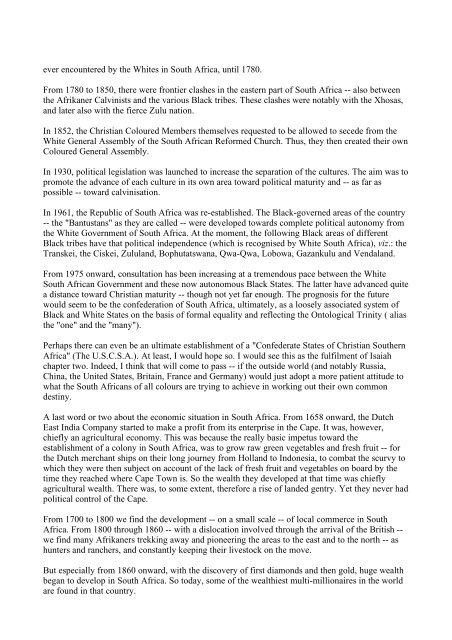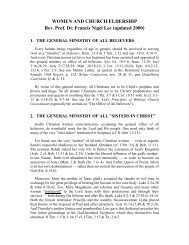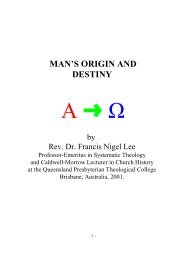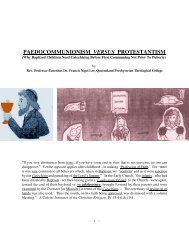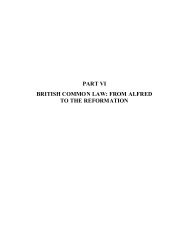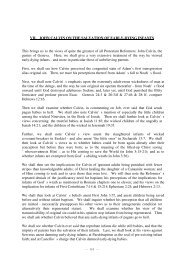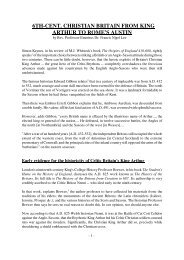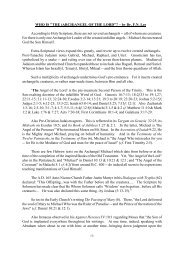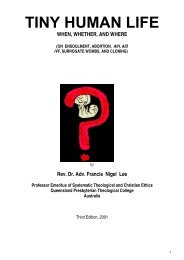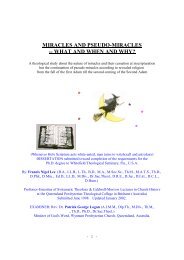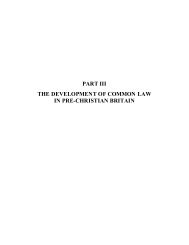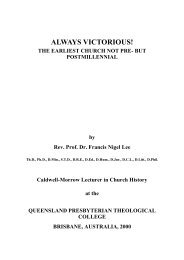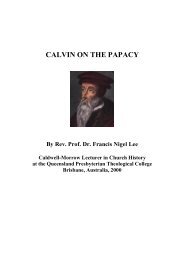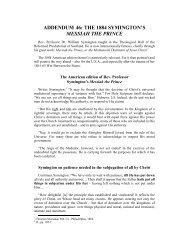As the text tells us: "Let us build a tower and a city, lest we be scattered over the face <strong>of</strong> the earth!"But God had purposed to scatter them. So He came down and twisted their tongues, acceleratingthe process <strong>of</strong> the development <strong>of</strong> languages which I think would have developed in any case. <strong>The</strong>nHe drove them apart from one another, into the various different areas <strong>of</strong> the world.In Deut. 32:8, Afrikaner Calvinists will tell you, it specifically states that when God divided thenations He did so according to the number <strong>of</strong> the tribes <strong>of</strong> Israel. In other words, the segregation <strong>of</strong>the nations by God into the different tribes and nations, took place so as to promote the expansion<strong>of</strong> the covenant people.<strong>The</strong>y, <strong>of</strong> course -- since the "Great Commission" <strong>of</strong> our Lord Jesus -- are now an internationalcovenant people. Yet even on the Day <strong>of</strong> Pentecost, this process <strong>of</strong> multiculturalism was notreversed. For Pentecost is not the opposite <strong>of</strong> the tower <strong>of</strong> Babel -- as the liberals allege.If it were, what would have happened at Pentecost is that every one would have spoken in the samelanguage -- possibly in Hebrew. <strong>The</strong>re would then have been a return to the monolingual situationwhich existed in the world before Babel. But instead, we find at Pentecost a sanctification <strong>of</strong> thecultural differences -- and a maintenance and a further development and a christianisation and anenrichment <strong>of</strong> them! Compare too Jeremiah 13:23 with Acts 8:27f.So Pentecost, far from being a return to Babel, is a mighty push forward <strong>of</strong> the cultures <strong>of</strong> theworld -- toward their ultimate goal prior to the second coming and especially on the new earththereafter. Revelation 21:24-26. <strong>The</strong>n the nations <strong>of</strong> them that are saved, shall bring the honour andthe glory <strong>of</strong> the nations into the city <strong>of</strong> God on the new earth -- in terms <strong>of</strong> Christ's "GreatCommission", which was linked to the cultural mandate, to go forth into all the world.Nations as nations are thus to be turned into Christ's disciples -- and to be taught to becomeChristian nations. <strong>The</strong>y are thus to maintain their God-given nationhood -- and in that way toobserve all things whatsoever Christ, the Second Person <strong>of</strong> the Trinity, had ever commanded.Well, so much for the theology <strong>of</strong> the basically Calvinistic Afrikaner approach to race relations. Ofcourse, this does not imply that Whites are superior to Blacks -- nor vice-versa. <strong>The</strong>y are allformally equal -- the one and the many! -- equal, but different. In spite <strong>of</strong> their many to-besanctifieddifferences, they all descend from Adam -- and all are being saved only by the one blood<strong>of</strong> the Second Adam.Of course at this particular time in history, by no means anything like most and still less all nationsin the world have yet become christianised to the extent that other nations have so far beenchristianised. <strong>The</strong> Afrikaner has been much more christianised at this stage <strong>of</strong> his development thanhave, for example, the Zulus (a Black nation in Africa). Indeed, even the Afrikaner nation needs tobe much more greatly christianised in the future than it has been up to this stage.It is the disparities at the various stages <strong>of</strong> christianisation <strong>of</strong> the nations which, <strong>of</strong> course, createsome <strong>of</strong> the tensions. This is so not only in South Africa, but throughout the world. Indeed, this isseen especially in those countries where disparate cultural groups <strong>of</strong> people coexist alongside <strong>of</strong>one another.Well now, in 1658 -- just six years after the arrival <strong>of</strong> the first White colonists -- a fence waserected between where the Whites were staying and the yellow-skinned Hottentot tribes werestaying (on the other side <strong>of</strong> the fence). From 1660 through 1760, Indonesian slaves were importedby the Dutch. No African Blacks were ever enslaved by African Whites. Indeed, no Blacks were
ever encountered by the Whites in South Africa, until 1780.From 1780 to 1850, there were frontier clashes in the eastern part <strong>of</strong> South Africa -- also betweenthe Afrikaner Calvinists and the various Black tribes. <strong>The</strong>se clashes were notably with the Xhosas,and later also with the fierce Zulu nation.In 1852, the Christian Coloured Members themselves requested to be allowed to secede from theWhite General Assembly <strong>of</strong> the South African Reformed Church. Thus, they then created their ownColoured General Assembly.In 1930, political legislation was launched to increase the separation <strong>of</strong> the cultures. <strong>The</strong> aim was topromote the advance <strong>of</strong> each culture in its own area toward political maturity and -- as far aspossible -- toward calvinisation.In 1961, the Republic <strong>of</strong> South Africa was re-established. <strong>The</strong> Black-governed areas <strong>of</strong> the country-- the "Bantustans" as they are called -- were developed towards complete political autonomy fromthe White Government <strong>of</strong> South Africa. At the moment, the following Black areas <strong>of</strong> differentBlack tribes have that political independence (which is recognised by White South Africa), viz.: theTranskei, the Ciskei, Zululand, Bophutatswana, Qwa-Qwa, Lobowa, Gazankulu and Vendaland.From 1975 onward, consultation has been increasing at a tremendous pace between the WhiteSouth African Government and these now autonomous Black States. <strong>The</strong> latter have advanced quitea distance toward Christian maturity -- though not yet far enough. <strong>The</strong> prognosis for the futurewould seem to be the confederation <strong>of</strong> South Africa, ultimately, as a loosely associated system <strong>of</strong>Black and White States on the basis <strong>of</strong> formal equality and reflecting the Ontological Trinity ( aliasthe "one" and the "many").Perhaps there can even be an ultimate establishment <strong>of</strong> a "Confederate States <strong>of</strong> Christian SouthernAfrica" (<strong>The</strong> U.S.C.S.A.). At least, I would hope so. I would see this as the fulfilment <strong>of</strong> Isaiahchapter two. Indeed, I think that will come to pass -- if the outside world (and notably Russia,China, the United States, Britain, France and Germany) would just adopt a more patient attitude towhat the South Africans <strong>of</strong> all colours are trying to achieve in working out their own commondestiny.A last word or two about the economic situation in South Africa. From 1658 onward, the DutchEast India Company started to make a pr<strong>of</strong>it from its enterprise in the Cape. It was, however,chiefly an agricultural economy. This was because the really basic impetus toward theestablishment <strong>of</strong> a colony in South Africa, was to grow raw green vegetables and fresh fruit -- forthe Dutch merchant ships on their long journey from Holland to Indonesia, to combat the scurvy towhich they were then subject on account <strong>of</strong> the lack <strong>of</strong> fresh fruit and vegetables on board by thetime they reached where Cape Town is. So the wealth they developed at that time was chieflyagricultural wealth. <strong>The</strong>re was, to some extent, therefore a rise <strong>of</strong> landed gentry. Yet they never hadpolitical control <strong>of</strong> the Cape.From 1700 to 1800 we find the development -- on a small scale -- <strong>of</strong> local commerce in SouthAfrica. From 1800 through 1860 -- with a dislocation involved through the arrival <strong>of</strong> the British --we find many Afrikaners trekking away and pioneering the areas to the east and to the north -- ashunters and ranchers, and constantly keeping their livestock on the move.But especially from 1860 onward, with the discovery <strong>of</strong> first diamonds and then gold, huge wealthbegan to develop in South Africa. So today, some <strong>of</strong> the wealthiest multi-millionaires in the worldare found in that country.
- Page 1 and 2:
THE CHRISTIAN AFRIKANERSA Brief His
- Page 3 and 4:
God richly bless the following lect
- Page 5 and 6:
There have always been, and always
- Page 7 and 8:
But the only one they both appeal t
- Page 9 and 10:
Now Zuidema was a very great Dutch
- Page 11 and 12:
Dutch churches at the Synod of Dord
- Page 13 and 14:
station -- to help the Dutch ships
- Page 15 and 16:
It is a country dedicated to freedo
- Page 17 and 18:
1760 -- there was more and more dis
- Page 19 and 20: with the Dutch. Many moved farther
- Page 21 and 22: said: "The British have placed our
- Page 23 and 24: financed by White money. It is buil
- Page 25 and 26: Famous Boer Generals, left to right
- Page 27 and 28: Three: Unannihilated: the Resurrect
- Page 29 and 30: (who had arrived in the country onl
- Page 31 and 32: of success.I may add that White Sou
- Page 33 and 34: General Beyers felt that those text
- Page 35 and 36: Balfour Declaration. The gist of it
- Page 37 and 38: Africa; treks on into the land both
- Page 39 and 40: Four: The Eschatology of Victory in
- Page 41 and 42: ide -- to use the instrumentality o
- Page 43 and 44: Christian National Calvinist Public
- Page 45 and 46: through constitutional process it h
- Page 47 and 48: I guess the best way to describe Sm
- Page 49 and 50: He was followed after his assassina
- Page 51 and 52: So the Scots came. I am going to sp
- Page 53 and 54: the Reformed Church in South Africa
- Page 55 and 56: ook on Hebrews. But his greatest wr
- Page 57 and 58: At that point, Du Plessis enquired
- Page 59 and 60: Yet quite apart from this high view
- Page 61 and 62: One last point. There is a tremendo
- Page 63 and 64: African Republic in 1902, the Cape
- Page 65 and 66: One of the most important Calvinist
- Page 67 and 68: Pellissier, who wrote on music and
- Page 69: perspective -- even while he minist
- Page 73 and 74: Now the United States does not need
- Page 75 and 76: majority of the White citizens are
- Page 77 and 78: Now you will not find in any of Sto
- Page 79 and 80: Finally, Stoker argues that the so-
- Page 81 and 82: This then brings Stoker to another
- Page 83 and 84: This Brummer just referred to, is a
- Page 85 and 86: Man was to rejoice in this nature (
- Page 87 and 88: enhanced. For, in the present, man
- Page 89 and 90: he declared, riddled with the ungod
- Page 91 and 92: Van der Waal is a very brilliant So
- Page 93 and 94: World War II when he was hiding fro
- Page 95 and 96: The Professor of Philosophy -- or I
- Page 97 and 98: glory.There are also Christian psyc
- Page 99 and 100: Then there are Christian criminolog
- Page 101 and 102: Massachusetts at Gordon- Conwell fo
- Page 103 and 104: well known -- is being pioneered in
- Page 105 and 106: people in South Africa. The South A
- Page 107 and 108: nature and of human culture (Prover
- Page 109 and 110: The parousia of Jesus Christ will i
- Page 111 and 112: more and more christianised. Later
- Page 113: END


